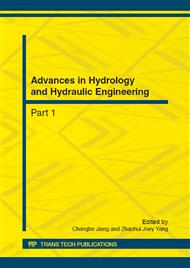p.290
p.294
p.299
p.307
p.311
p.316
p.323
p.327
p.332
Analysis of Precipitation Concentration in Gaoyou Irrigation District: Implications for Increasing Effective Rainfall
Abstract:
The humid region in south China has abundant rainfall. In order to make effective use of rainfall and save irrigation water, we collected the historical precipitation data of Gaoyou Irrigation District for the past fifty years and used the Geordie Coefficient model of precipitation time evenness index to calculate the precipitation concentration index in different growth stages of rice. The results showed that the precipitation concentration index was low in the early stages of rice; while it gradually increased in the later stages. The precipitation concentration index reached the minimum during the jointing-booting stage and the peak the maturing stage. There were also deceasing trends in precipitation concentration for the early stages. Therefore, it is possible to make better use of rainfall in the early stages of rice growth and save irrigation water. It is necessary to investigate accuracy of rainfall forecasts in future studies.
Info:
Periodical:
Pages:
311-315
Citation:
Online since:
October 2012
Authors:
Price:
Сopyright:
© 2012 Trans Tech Publications Ltd. All Rights Reserved
Share:
Citation:


